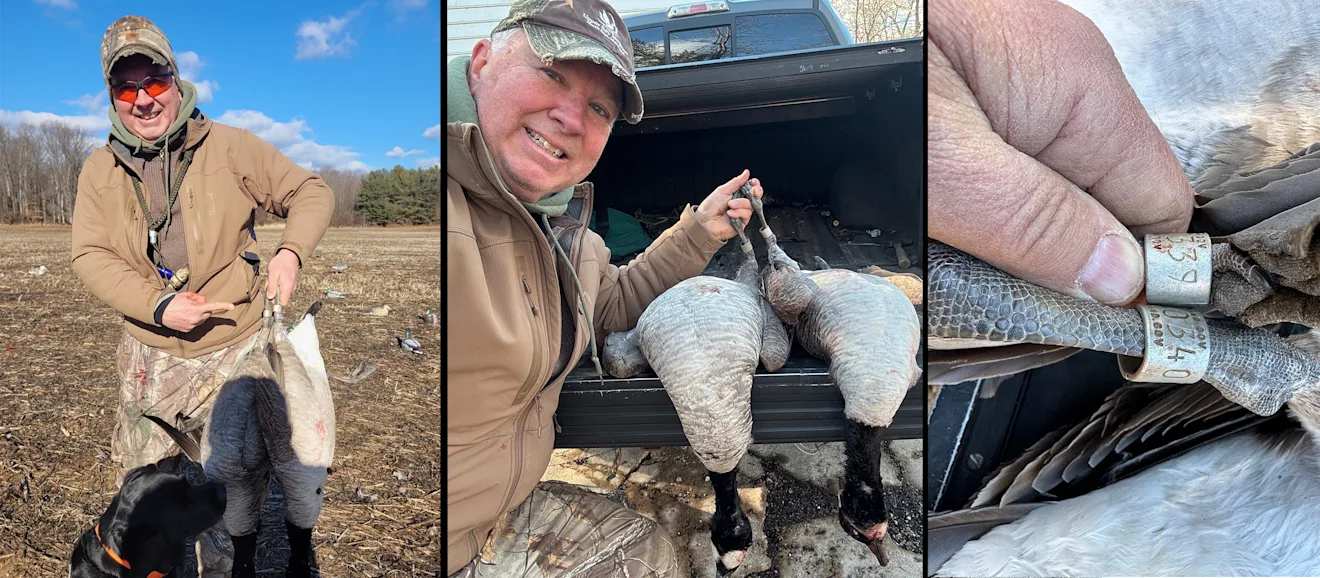Other than mallards, no North American waterfowl species have been banded more than Canada geese. If you hunt honkers often, shooting one sporting a piece of jewelry isn’t as rare as you might think. Over 3 million geese have been banded since the early 1900s, with just over 1 million encounters.
Now, killing two banded geese in one day is much less common. But shooting two geese with consecutive band numbers is almost unheard of. In 1962, Dr. Stan Chace did just that when he killed a banded Canada goose in October, and then two months later killed another banded goose that revealed a consecutive band number to the first.
This was a one-of-a-kind story until two weeks ago when Glenn Gillis of Perryman, Maryland, killed two Canada geese with consecutive band numbers. To take this rare encounter to the next level, he shot the birds as a double to fill his two-bird limit on the last day of the season. Here’s how it happened.

A Bean Field Surprise
It was the final day of the Maryland goose season, and Gillis met his hunting partner, Junior Mayfield, at their pit blind. Early in the morning, Mayfield killed two geese to fill his limit. All that was left was for Gillis to bag his two birds and call it a season.
“Around 10:15, a group of nine geese came in behind me,” said Gillis. “Junior called the shot, and I popped up, turned, and dropped a bird.” When Gillis came out of the blind, the flock split. “Then I turned to the front of the blind, identified another bird, and killed it," said Gillis.” Just like that, he had his two-bird limit. But he was about to find out how rare this double was.
“My buddy hopped out of the pit to retrieve the first bird,” recalled Gillis. “I sent my British lab, Kona, to get the second.” That’s when Gillis heard his friend hooting and hollering. The first goose was banded. “I was getting out of the blind to see the banded goose when Junior grabbed the other bird from Kona,” Gillis said. “Then he started hollering even more because the other bird was also banded.” Most hunters would agree that there's no better way to end a waterfowl season than with a clean double. Tack on bands for both birds, and it's probably time to buy a lottery ticket. But somehow, his unlikely day was about to get even crazier.

Band Report
It wasn’t until Gillis inspected the bands that he realized they had consecutive numbers—1328-40339 and 1328-40340. “What are the chances of that?” Gillis asked. While researching the craziest waterfowl bands ever recovered, we only came across one instance of a hunter killing consecutive bands.
Both geese were two years old and banded near Phoenix, New York—about 335 miles from Perryman, Maryland. Gillis, who's retired, didn't start seriously hunting until about 15 years ago. During that time, nobody in his hunting group has killed a band out of that pit blind, he said. “In 2014, my son shot a banded bird close to where I was hunting,” said Gillis. “But that’s the last band I’ve seen on a hunt.” These were the first two bands of Gillis' life—and it's safe to say it was well worth the wait.


